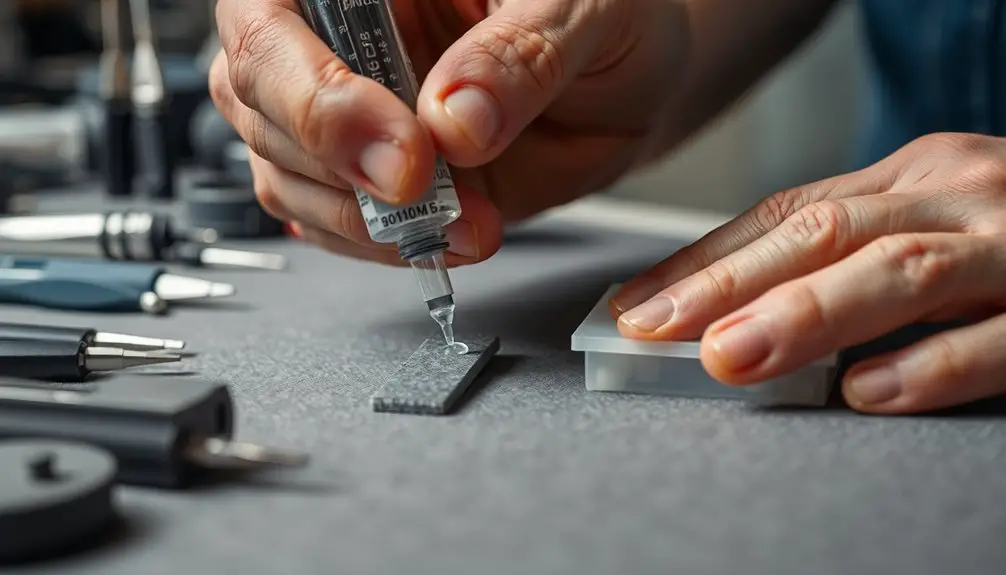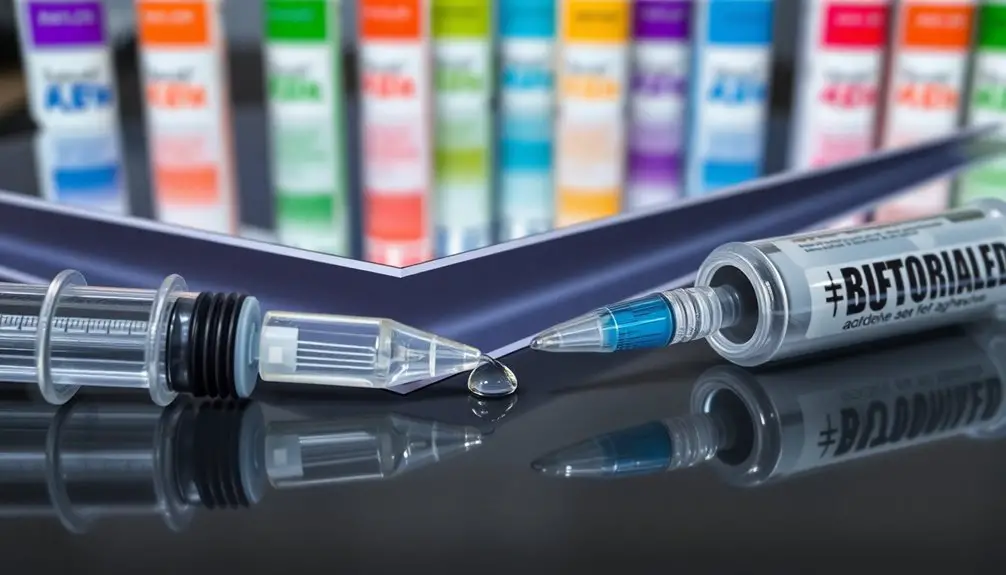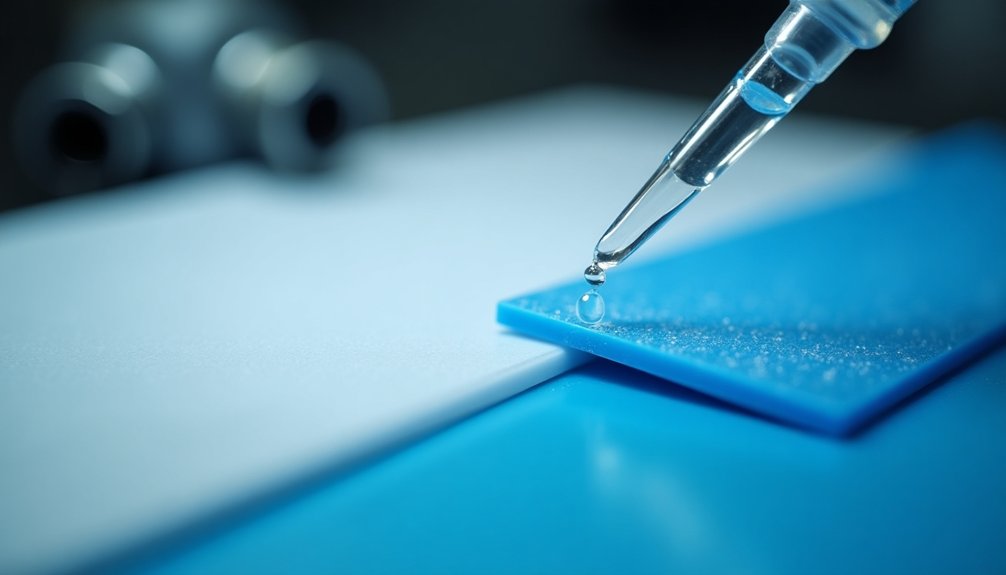Bonding polypropylene effectively requires you to tackle its low surface energy, which complicates adhesion. Start by choosing specialized adhesives, like Infinity Bond MMA 500 or Loctite Super Glue All Plastics, that cater to polypropylene. Surface preparation is crucial—light sanding or using specific primers can enhance adhesion. Alternatively, consider plastic welding to achieve a strong bond by melting the surfaces together. Be mindful of temperature resistance in adhesives to prevent bond failures. Understanding these techniques will help you achieve durable results. For insights on additional methods and recommendations, explore further options tailored for successful bonding.
Key Takeaways
- Choose polypropylene-specific adhesives like Infinity Bond MMA 500 for effective bonding due to polypropylene's low surface energy.
- Consider plastic welding for strong fusion by heating surfaces to their melting point, ensuring a durable bond.
- Surface preparation, such as light sanding or using primers, can enhance adhesion by increasing surface energy.
- Use adhesives like SuperTAC 500 and Loctite Super Glue All Plastics for quick and effective bonding without extensive surface treatment.
- Consult with adhesive experts for compatibility assurance to ensure optimal bonding results with polypropylene materials.
Background of Polypropylene
Understanding polypropylene is crucial, as it's the second most used plastic worldwide, just behind polyethylene. You'll find polypropylene (PP) in a variety of applications, from packaging to automotive components and textiles. Its versatility makes it integral across many industries.
One standout feature of polypropylene is its excellent chemical resistance, which allows it to perform well even under harsh conditions.
When it comes to bonding, polypropylene can be difficult due to its non-porous surface. Proper surface preparation is essential to achieve a strong bond. You'll want to use the right adhesive specifically designed for polypropylene to ensure success.
The high strength-to-weight ratio of polypropylene enhances its utility, particularly in the automotive sector, where every ounce counts for fuel efficiency.
Some grades of polypropylene even exhibit impact resistance similar to acrylonitrile butadiene styrene (ABS), opening up more applications in demanding environments.
If you're looking for the best solution for bonding polypropylene, understanding its properties and how to work with them will be key to achieving durable and reliable results.
Additionally, selecting a suitable adhesive for polypropylene is similar to choosing the right adhesive for PVC cement alternatives, as both require careful consideration of their material properties and characteristics.
Challenges in Bonding
Bonding polypropylene presents unique challenges that can frustrate even seasoned professionals. One of the primary issues is its low surface energy, around 29 mJ/m², which makes it difficult to bond with most common adhesives that typically require higher surface energy. This results in significant adhesion challenges that can undermine the effectiveness of your bonding efforts.
Consider these key factors:
- Mechanical fastening methods, like drilling, can compromise the structural integrity of polypropylene components.
- The heat generated during bonding processes can weaken the material, leading to potential bond failures.
- Mechanical pretreatment techniques such as sanding and sandblasting are often time-consuming and may not yield effective results.
- Advanced treatments, including plasma and corona treatment, can be effective but often come with high costs and variable results.
Given these difficulties, it's clear that bonding polypropylene requires careful consideration and planning.
Understanding the limitations inherent in low surface energy plastics is crucial. You'll need to explore innovative solutions, like specialized polypropylene adhesives, to enhance your chances of achieving a strong, lasting bond. Additionally, being aware of the chemical properties of polypropylene, such as polypropylene's recyclability, is essential in ensuring safe and effective bonding practices.
Effective Bonding Methods

When it comes to effectively bonding polypropylene, you'll find several methods tailored to overcome its unique challenges. One popular approach is adhesive bonding, where adhesive selection is crucial. You'll want to choose a polypropylene glue designed specifically for low surface energy plastics, like Infinity Bond MMA 500. This structural adhesive requires minimal surface preparation, making it user-friendly. In projects requiring vinyl adhesion, selecting the right adhesive like vinyl-specific adhesives is also crucial to achieve a strong bond.
If you prefer a more hands-on method, plastic welding can be highly effective. This technique involves heating the polypropylene surfaces to their melting point, allowing them to fuse together, resulting in a robust bond suitable for larger components.
While mechanical fasteners like screws or rivets may seem convenient, they can weaken the integrity of polypropylene, so think carefully about their use based on your application.
Regardless of the method you choose, always consider temperature resistance and ensure the adhesive provides a strong bond without compromising the material.
Lightly sanding the surfaces or using primers can enhance adhesion, increasing the surface area and energy, making it easier for your selected adhesive to bond polypropylene effectively.
With the right technique, you'll achieve a durable and reliable connection.
Importance of Surface Energy
Surface energy plays a crucial role in the adhesion process of polypropylene. With a surface energy of approximately 29 mJ/m², polypropylene presents a challenge for bonding since most common adhesives have a surface energy above 38 mJ/m². This disparity can lead to weak bonds if not addressed properly.
Low surface energy of polypropylene requires adhesives with similar properties or specialized formulations. Inadequate surface energy results in poor adhesive penetration, necessitating effective surface preparation. Using the right adhesives directly impacts the durability and strength of the bond formed. Recent advancements in low surface energy adhesives are promising, but their market availability remains limited.
To achieve effective bonding, you must prioritize surface energy in your adhesive selection. Without addressing the differences in surface energy, you risk creating weak bonds that compromise the overall integrity of your project. Proper surface preparation and choosing the right adhesives designed for low surface energy plastics will enhance your bonding results, ensuring a strong and durable connection. Furthermore, a better understanding of HDPE vs. LDPE can also be beneficial when selecting the right polyethylene type for specific applications.
Recommended Adhesives for Polypropylene

Choosing the right adhesive for polypropylene is crucial to achieving a strong, durable bond. Since polypropylene has low surface energy, it's essential to select recommended adhesives specifically designed for this material.
One excellent choice is Loctite Super Glue All Plastics, which bonds quickly and dries transparent, providing a seamless finish.
For a more permanent bond, consider Infinity Bond MMA 500. This two-part adhesive requires minimal surface preparation and delivers effective results within 24 hours.
If you need a high-performance option, SuperTAC 500 is a hot melt adhesive that can withstand extreme temperatures without pre-treatment, making it ideal for various applications.
Another reliable choice is Forgeway's Purok VX90, formulated for low surface energy plastics, ensuring compatibility and effective bonding with polypropylene.
When selecting an adhesive, always consult adhesive experts to ensure the compatibility of your chosen product with polypropylene. This is particularly important when working with PP 5 Plastic, as its unique properties may affect the bonding process.
Frequently Asked Questions
How to Bond Polypropylene Plastic?
To bond polypropylene plastic effectively, you'll need specialized adhesives designed for low surface energy plastics. Prepare the surface by lightly sanding it, and consider using mechanical fasteners or plastic welding for stronger connections.
Does JB Weld Plastic Bonder Work on Polypropylene?
Yes, JB Weld Plastic Bonder works on polypropylene. Just make sure you prepare the surfaces properly by cleaning and roughening them for the best bond. It'll provide a strong, durable hold once cured.
What Is the Best Bonding Agent for Polyethylene?
When bonding polyethylene, you'll want to use specifically formulated adhesives like Infinity Bond MMA 500 or SuperTAC 500. These options provide strong, permanent bonds without needing extensive surface preparation, ensuring durability in various applications.
What Is the Best Way to Repair Polypropylene Plastic?
To repair polypropylene plastic, use specialized adhesives designed for low surface energy. Lightly sand the surfaces for better adhesion, apply a small drop of adhesive, and press them together firmly for a strong bond.

